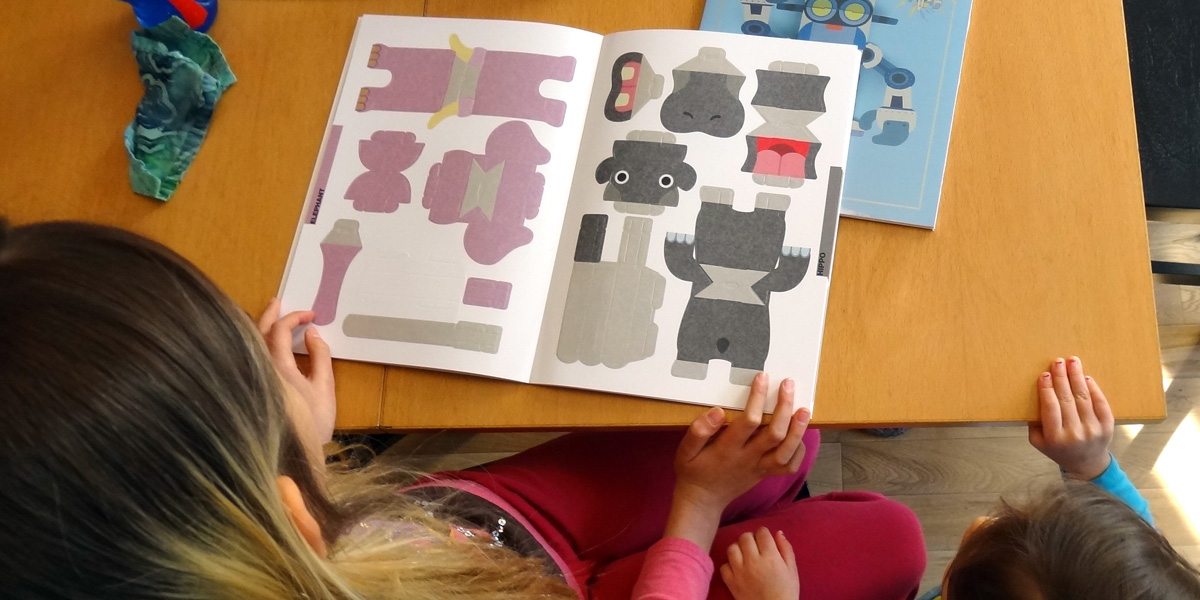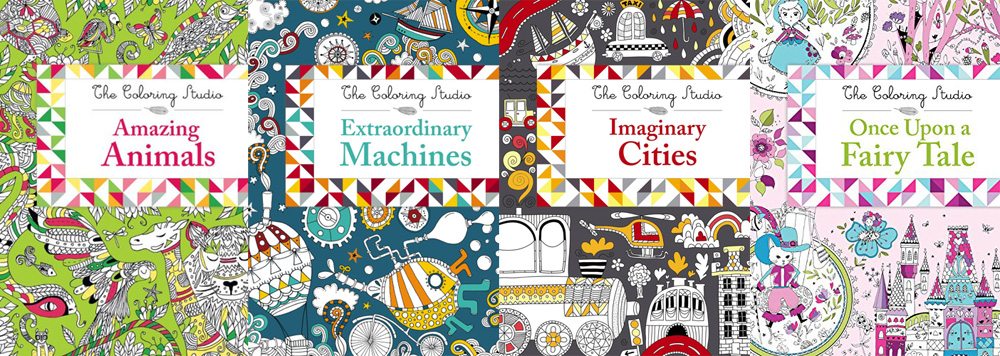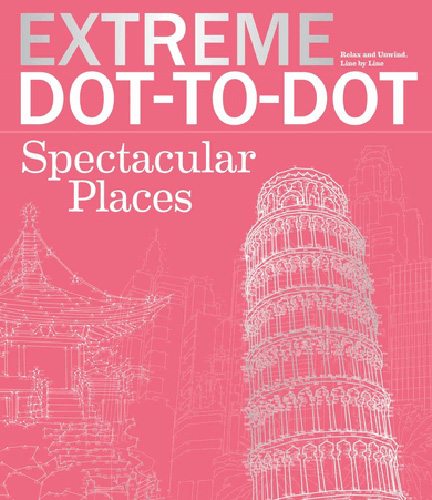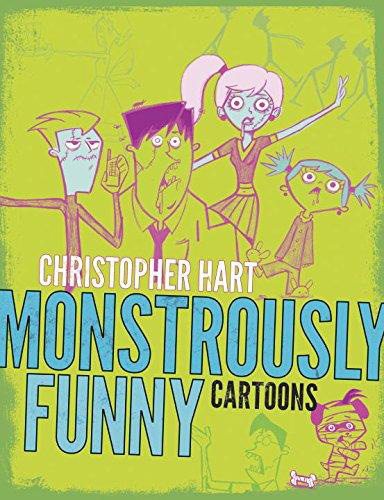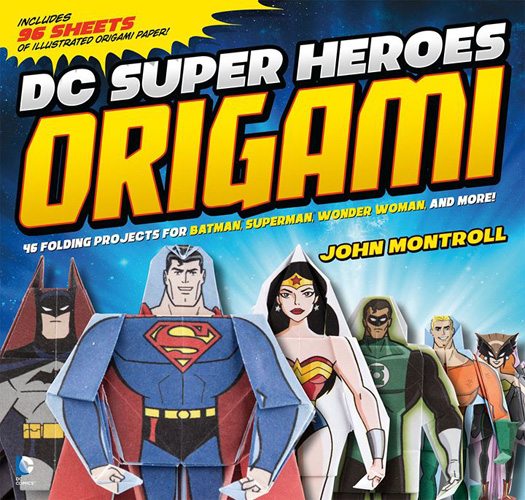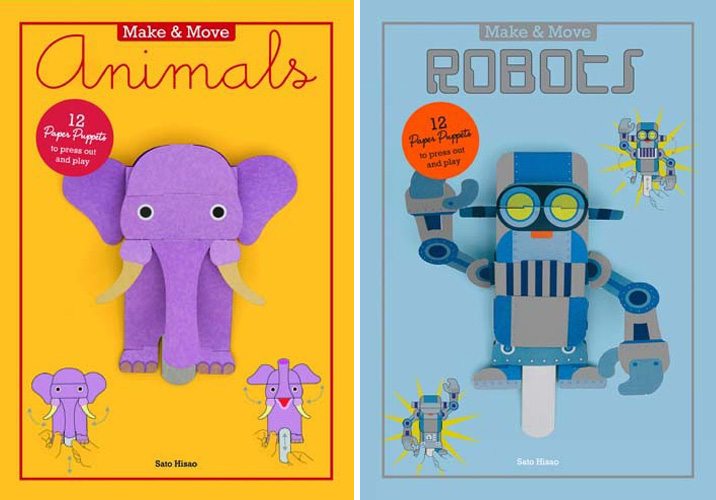
Today’s Stack Overflow is all about arts and crafts: coloring books, dot-to-dot books, and other fun activities.
Over the past few months I’ve gotten a flood of coloring books, many of them designed for adults. If you’ve visited a bookstore or even an art supplies store lately, you’ve probably seen them: mandalas, cityscapes, animals, and more. (Jenny Bristol wrote up a few favorites last summer.) I can’t possibly share all of them, but here are a few highlights.
Many of the recent coloring books are too difficult for younger kids–they’re simply too intricate and require a little too much time and patience. This series, from Little, Brown, is a step up from kiddie coloring books but still kid-friendly. Yes, there’s a lot to color in, but there are some larger areas to fill in and most of the pages have some portions pre-colored (though sometimes it’s just the background). My favorite of the three pictured above is Extraordinary Machines by Claire de Moulor.
Patterns of the Universe by Alex Bellos and Edmund Harris
This coloring book will appeal to math geeks–the patterns in it are all based on various mathematical patterns and geometric shapes, and there are even instructions on creating your own patterns. For instance, the Voroni Diagrams are a way to divide up a plane into cells, starting with a bunch of dots, either randomly placed or in a pattern. There are also fractals, tessellations, knots, and more. It’s a really fun way to visualize math.
The Menagerie illustrated by Claire Scully and Richard Merritt
The bulk of the coloring books I have are from Barron’s, which has such a huge line that I can’t possibly tell you about all of them. But here’s one eye-popping example. The Menagerie has animal portraits that are made up of tiny intricate shapes–they’re intended to be dazzling rather than realistic, and will take a long time to color. One nice thing about many of Barron’s coloring books is that the pages are perforated so you can pull them out–a lot easier than trying to hold the book flat so you can color it.
Mythic Coloring Book by Charles Vess and Michael Kaluta
I’ve always been a fan of Charles Vess’s fairy tale artwork, and here’s a coloring book of his illustrations. I wasn’t familiar with Michael Kaluta, but his artwork is in a similar vein. This coloring book is two books in one, with one half of Vess’s drawings and one half of Kaluta’s. The illustrations are incredibly detailed, as you can see from the cover–I would say you probably shouldn’t expect your final images to turn out like these–but if you love fairy tales this is a beautiful book to color.
Extreme Dot-to-Dot: Spectacular Places
Barron’s also has a dot-to-dot series for older kids and adults. We’re talking about a lot of dots. The pictures in Extreme Dot-to-Dot: Spectacular Places go up to 1,200 dots each. I like the architecture in Spectacular Places, but there’s one problem: each page has a little factoid about the image on the facing page … except that the pages are perforated. Once you tear them out, you’ll have a random factoid on the back of your picture that belongs to some other image, with no good way to connect them. Some of the dots are greyed out–I think it’s just in places where there are a lot of numbers, but it’s never explained.

Ultimate Dot-to-Dot by Gareth Moore
Ultimate Dot-to-Dot pictures are a little easier, with around 800 dots on some images, but the book is much larger so the images are pretty impressive. This book uses color as a feature, too. The dots are in color, and will switch to different colors in the picture. There are also hollow dots, indicating that you don’t draw a line to the next number, and the last dot is helpfully indicated with a hollow star so you know you can quit searching.
Draw-a-Saurus by James Silvani
For those interested in making their own images, I’ve got a few suggestions, too. First up: dinosaurs! James Silvani’s drawing methods are similar to the books I grew up with: start with the ovals, basic shapes that you connect and then build up to the details. However, the drawing book itself is full of other things, too–fun facts about dinosaurs and a lot of silly humor (accompanied by little notes from his annoyed editor). It’s also longer and more detailed than many of the how-to-draw books I’m used to, at about 150 pages. Whether you want to draw serious or silly dinos, Draw-a-Saurus is a great place to start.
Monstrously Funny Cartoons by Christopher Hart
My kids got a kick out of this one, which has step-by-step instructions for creating some funny mummies, zombies, vampires, and more. These are pretty cute and the drawings have a lot of personality, but it does seem like the sort of book where you learn to draw these particular images–I’m not sure how well it translates into drawing other things in a similar style.
The World Record Paper Airplane Book by Ken Blackburn and Jeff Lammers
Now, on to paper crafts! First up: this book is all about how to make paper airplanes, including the plane that won the Guinness World Record for time aloft. The beginning of the book is an introduction to paper airplanes, including the story of the world record, an explanation of aerodynamics, and guides to throwing techniques. There are 20 different plans to make and fly, with 112 tear-out sheets that are pre-printed with colorful graphics and (more importantly) fold lines. I’d recommend cutting out the pages with scissors or a knife though, because tearing along the perforation often resulted in ragged edges or tears, which aren’t great for aerodynamics (see chapter 2).
DC Super Heroes Origami by John Montroll
My middle daughter is a huge fan of origami, and every available space in our house is covered in paper cranes, dragons, scorpions, and other little masterpieces. This book is full of various comics-inspired creations, from Wonder Woman’s boot to Superman’s crest to the Penguin’s umbrella. It makes use of 96 sheets of pre-printed origami paper so that your final creations will be properly colored.
Zen Doodle Origami by Carolyn Scrace
Zen doodling (sometimes called zentangles) are a sort of guided doodling–creating structured patterns, usually in black and white, that often result in the sort of detailed patterns that you see in many of the adult coloring books now. This book combines zen doodles with origami–it teaches you how to fold particular objects and shapes, and then gives ideas on how to decorate them. It includes 20 sheets of origami paper, but certainly the ideas in it could be extended to just about any origami creations.
Make & Move Animals and Make & Move Robots by Sato Hisao
These papercraft books result in little creatures that actually move around. You punch out the paper and cut and fold, insert tabs into slots, and in the end you get a little model that blinks its eyes or moves its arms or flaps its wings. Each model includes folding a little control stick that slides up and down to activate the model. When I got this book, my daughters immediately made just about all of the models in one evening. Each book includes 9 pre-colored models and 3 that just have the black-and-white illustrations for you to color in yourself.

Disclosure: I received review copies of the books in this column.
